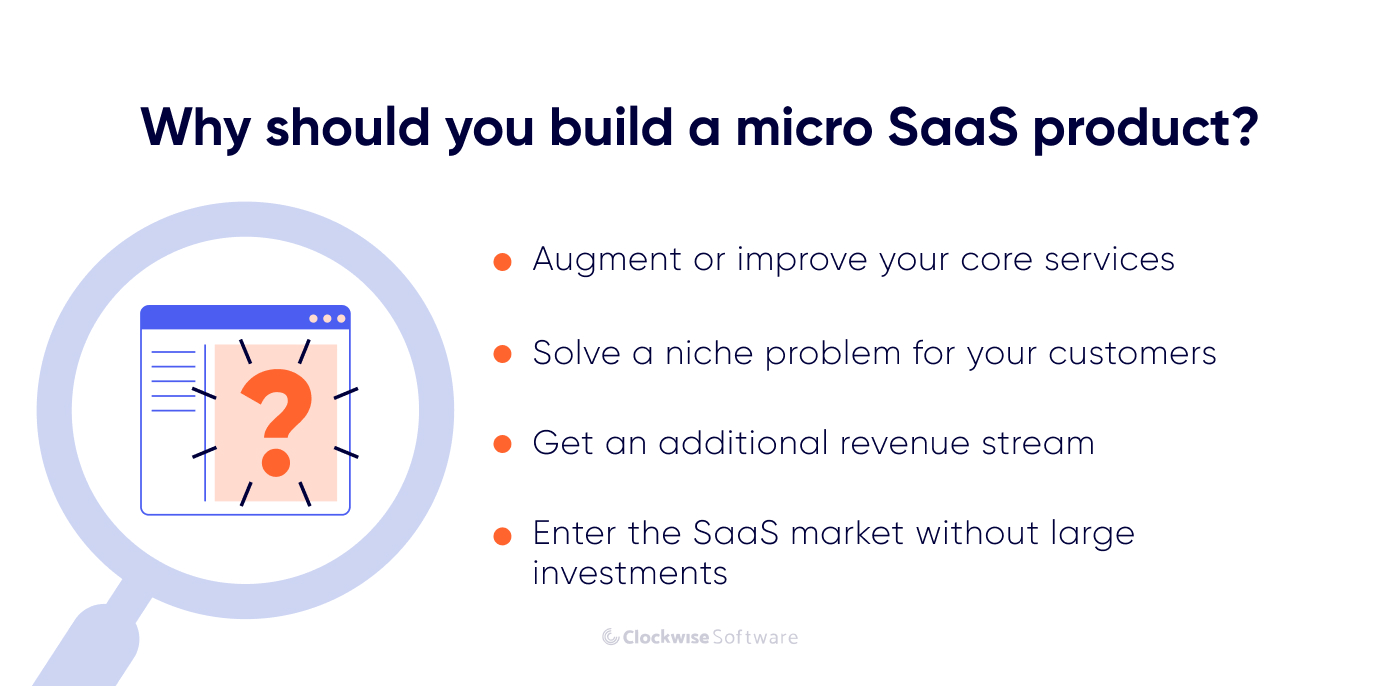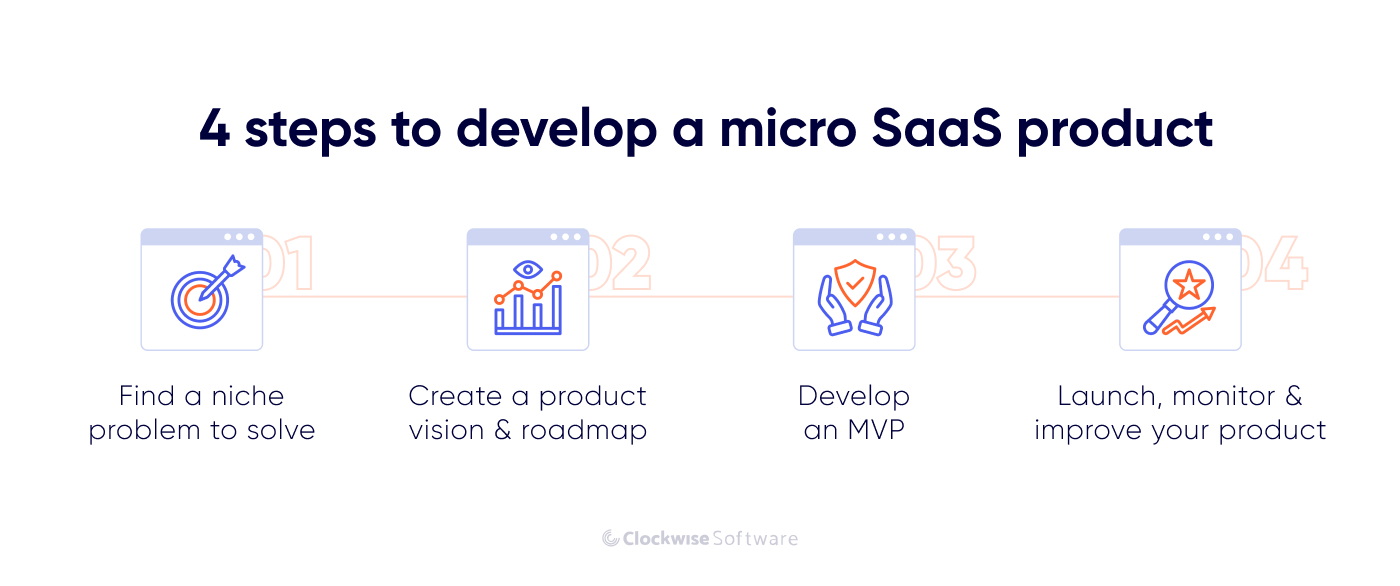What we do
Services
Experts in
Looking for ways to enter the SaaS market, companies frequently think of creating versatile solutions that serve multiple needs and attract a wide audience. But while there’s nothing wrong with this approach, it’s not the only way to build a successful SaaS product.
Launching a small micro SaaS solution targeted at solving a specific problem is an alternative way to succeed. Micro SaaS solutions allow companies to avoid risks and create profitable products with fewer resources compared to launching a traditional startup.
If you are considering building a micro SaaS product, this article can help you learn more about the topic. We explore the concept of micro SaaS, examples of successful projects, and how to build a micro SaaS product that you can grow into something bigger.
Let’s start by answering the question What is micro SaaS?
A micro SaaS product is a small-scale solution tailored to a specific problem within a certain niche and provided to users according to the SaaS business model. It usually offers a set of features needed to tackle a certain task and, therefore, takes much less time to build than a traditional SaaS product, whose functionality covers a wide range of tasks.
Niche-specific SaaS products appeared because large SaaS providers frequently overlook certain users’ needs. Functionality that meets these needs may not be relevant to most users, so it doesn’t seem rational for software providers to offer it in a one-size-fits-all solution.
Micro SaaS products provide this missing functionality, catering to the underserved needs of businesses and average users. Such products can come as extensions to existing products or standalone apps, depending on their purpose.
What are other characteristics of micro SaaS solutions? We explain them through comparison with traditional SaaS products.
Micro SaaS products share several essential characteristics with their traditional SaaS counterparts: they are scalable, hosted in the cloud, may have a multi-tenant architecture, and are provided via a subscription-based pricing model. However, there are several characteristics that set micro SaaS tools apart from traditional software as a service products:
Scope
A micro SaaS product addresses a single problem or meets one particular need. Thus, its feature set is focused on accomplishing one task and is smaller than that of regular SaaS solutions, which provide broad functionality for multiple tasks.
Development team composition
Micro SaaS products are usually developed by one person or a small development team, while traditional SaaS products require a more extensive software engineering team structure to be finished in a reasonable time frame.
Funding
Building micro SaaS products doesn’t require massive resources, so they are usually self-funded. Traditional SaaS products cost more, so in addition to investing their own resources, startup founders frequently raise funding from third-party investors.
Time to market
Developing and testing small-scale solutions takes less time than for all-encompassing products. Additionally, you don’t need to agree on the launch date with stakeholders and investors, so you can launch faster.
Competition
Micro SaaS products usually have low competition, as they are created for niches that are untapped by other startups. Traditional SaaS products, in turn, usually operate in a highly competitive environment, as there are many feature-rich SaaS solutions for any industry (take, for example, CRM systems, project management tools, or e-commerce solutions).
Profitability
Niche solutions have a limited audience, so their potential revenue is lower than that of traditional SaaS products. However, micro SaaS startups can be quite profitable, as they require fewer operating expenses and don’t rely on external funding. This allows for better control over expenses and prioritization of business sustainability over quick growth and expansion.
As you can see, micro SaaS products differ greatly from traditional SaaS products in terms of how they’re funded, built, launched, and operated. So, in what cases can building a micro SaaS product be the best option? Let’s see.
Creating small-scale solutions can be beneficial in many cases. In this section, we describe four main reasons for building a micro SaaS solution.

If you run a service business, micro SaaS can help you to provide better services or scale your services. For example, a marketing agency that helps with managing social media accounts can create a micro SaaS app for scheduling and managing content publishing. By offering this app, the agency can scale its services and reach a new audience that isn’t yet interested in customized services.
Our BackupLABS SaaS platform development case study is another example of how building a micro SaaS app can help to improve services. BackupLABS helps companies back up data from various third-party services. Before contacting us, they were using a third-party backup platform while managing the operational side of the business.
However, the third-party product could back up data only from several applications, such as Salesforce and Microsoft 365, which didn’t cover all the needs of BackupLABS customers. Thus, the client decided to create their own SaaS backup platform that would cover more applications, including Asana, GitLab, and GitHub. With our help, they built a platform that filled a gap in the market and improved their services.
When we use certain tools or work in a certain industry for a long time, we can sometimes notice use cases that aren’t covered by existing solutions. If you identify an unmet need or unsolved problem, building a micro SaaS app can help you both solve a problem for yourself and others and get a new revenue stream.
Take a look at Hypefury, a social media automation tool.
The idea for Hypefury came to founder Samy Dindane when he was using Twitter (now X) and asked a simple question: “Is it possible to schedule threads?” It turned out there were no tools for this, so Samy decided to create one. It took him three days to build a pilot project with functionality for scheduling threads, and he further improved his product based on users’ feedback and requests.
Samy found a niche problem and solved it, and now Hyperfury brings almost $300,000 yearly to him and his team.
The next reason is quite obvious: you can create a micro SaaS solution to get a new revenue stream for your company. The small scale of the solution makes its development affordable, and subscriptions offer recurring and predictable revenue.
You can create a standalone product that is in the same domain as your business but doesn’t directly augment your services. Or, if you have a custom app that you use internally but think could be valuable for others, you can start SaaS migration and turn your app into a micro SaaS app. After launching it, you can evaluate its viability and grow it further into an all-in-one product.
No matter what micro SaaS solution you want to create, there is always one condition for making a successful product: it should solve a certain problem in a certain niche.
If you’re not ready to invest a large amount of resources in software product development but would like to enter the SaaS market, there is nothing better than starting with a micro SaaS app.
Along with low upfront investment, a short time to market, and little to no competition, this option has another benefit: you can scale your product and achieve the same success as with a traditional SaaS product.
Looking for an example? Take a look at Linktree, a popular marketing tool for creating a webpage to host links to your website, social media accounts, and other online platforms.
Linktree was created in 2016 as an answer to a basic problem — many social media platforms allow adding only one link in the bio, while users, especially influencers and organizations, frequently want to add more.
The Linktree website was built in six hours for use by the founders’ main business — a digital music and entertainment agency. However, it turned out the link in bio issue was shared by many other social media users. When Linktree’s founders introduced the platform to their clients, word spread fast, and soon, Linktree started to get more and more sign-ups each day. In three years, the platform had three million users. Today, the number has grown to over 35 million.
Linktree has a very specific niche with a specific audience, but that hasn’t stopped it from growing from a side hustle into a full-fledged company. The product succeeded because it addressed an unsolved problem and brought new value.
There are many other successful micro SaaS examples, such as Storemapper, a tool for adding a store locator on a website; SolidGigs, a platform for automating freelance job searches; Paperform, an online form builder; and some of the fastest-growing SaaS companies we wrote about earlier.
Even though the micro SaaS trend is not new and the market offers numerous niche solutions, there are still many niches waiting for the right micro SaaS products. You have a chance to fill those gaps with your micro SaaS solution.
So, how can you build one? We have a guide for you.
Micro SaaS products are much faster to develop than regular SaaS apps, but to succeed, you still need the right approach to development. The process of building and launching a micro SaaS product is similar to the phases of startup development. Here is a four-step guide on how to build a micro SaaS product.

To create a profitable product, you need to make sure it can bring value to users. Thus, to come up with micro SaaS ideas, you should start by defining unmet needs and wants.
If you work in a certain niche and have an unsolved issue that slows down your workflow, try to research if other niche players have the same issue. Chances are, your problem will resonate with other businesses too, in which case it makes sense to think about how to solve this problem through a micro SaaS product.
Another way is to focus on your clients’ requests or feedback on your services. Do clients have needs you aren’t currently covering? By analyzing feedback and customer interactions with your business or conducting interviews and surveys, you can identify commonly underserved needs.
Understanding whether there is demand for the solution you’re going to build plays an essential role in your product’s success. Take your time to make sure you find a problem worth building a micro SaaS tool to solve.
Once you find a problem, it’s time to think about your product vision. What solution can solve that problem? You will need to brainstorm micro SaaS business ideas and choose the most viable one.
Answering these and many other questions will help you shape your product’s vision, understand what architectural design to choose and what functionality to develop, as well as consider user flows, industry-specific requirements, and possible risks. To guide your development process, you need to document this information in project requirements.
At this step, you also decide on the tech stack for your SaaS product. This involves choosing a cloud provider, frontend and backend technologies, and third-party APIs that will help you to implement your micro SaaS idea in the best way. You can create a proof of concept to test the technical feasibility of your product implementation with the chosen tech stack.
Last but not least, you need to create a development plan. Decide what features you will work on first, set a timeline for each development stage, from design to testing and launch, and document this information so you can easily monitor your project progress.
Creating a product vision and development plan requires expertise in software development. If you have such expertise, you can do everything yourself. If not, it’s better to hire a software development team (or just one specialist, depending on your project scope).
With well-defined project requirements and a development plan, you can create an MVP.
An MVP is a version of your product that contains enough features for users to complete a task and for you to test your business hypothesis. Its main purpose is to develop and launch a product early so you can gain user feedback, validate your idea, and decide what direction to take.
The time required for micro SaaS MVP development can vary significantly depending on your project’s size. It can take only one month to build your MVP if the feature set is small. However, the greater the scope of work, the longer it will take. You can estimate an accurate timeline with your development team.
With a developed MVP, you can finally enter the market. You can start to promote your app before its release using social media, email, industry-specific communities, and other channels. The choice is entirely yours; focus on those channels that you can effectively leverage using your available marketing and launch budget. Also, it’s helpful to decide in advance on metrics to measure your success.

Once your app is launched, your main task is to monitor its performance and user feedback to understand what you should do further to ensure its success. Sometimes, your micro SaaS idea may prove to be not as good as expected — this is a sign for you to pivot and find another way to solve the problem.
If your app performs well, you can plan further development based on user feedback. At the same time, you need to react quickly to any issues your users encounter in your app (and they will, because no MVP is perfect), provide quality customer support, and fix bugs.
Maintenance and improvement is the last stage of the SaaS lifecycle, but it never really ends. You need to monitor and maintain your product’s performance and release updates from time to time to ensure a great user experience and, therefore, customer retention and loyalty. Due to the small scale of the project, a micro SaaS app won’t require all your time, and if you use IT services outsourcing, your development team can handle product maintenance.
Let’s say your micro SaaS product is gaining traction: you’ve attracted users, customer churn is low, feedback on your product is great, and users ask about additional features. At this point, you can start thinking about turning your micro SaaS app into a full-featured product.
Can you do it? Yes, and it is perhaps one of the best options to grow a successful full-fledged SaaS product. Why? Rob Walling, serial entrepreneur and co-founder of startup accelerator TinySeed, explains it best:
The genius of niches is they are too small for large competitors, allowing a nimble entrepreneur the breathing room to focus on an underserved audience. Once you’ve succeeded in that niche, you can leverage your success to establish credibility for your business to move into larger markets.
What actions does such transformation require? Here are three steps to take:
Rethinking your product vision and creating a product roadmap
You should begin with a startup discovery phase. It involves analyzing competitors and users, identifying additional needs you want to cover, planning new functionality, and deciding on changes in your SaaS application architecture to match the new app requirements.
With a new product vision, you can create a product roadmap: a plan for how you want to improve and grow your product over time. Based on this information, you can create a detailed development plan.
A discovery phase is essential for ensuring a smooth development process and reducing possible risks. It allows you to start your product transformation with a clear project vision, an understanding of necessary changes, and a structured development plan.

Expanding the software development team
To effectively handle the growing scope of work, you will need to expand your team.
If you’re already outsourcing micro SaaS development, your vendor will expand the team to match the project scope.
If your product was initially developed by in-house developers, you can hire new specialists or choose a SaaS application development company and outsource the entire scope of development to them. This option is great, as you don’t need to worry about recruiting new specialists each time the project scope grows — your vendor will take care of scaling the team up or down according to your project needs.
Re-estimate required investments
Building a full-featured SaaS app requires more investments than building a micro SaaS app. With new project requirements, you can estimate your budget and understand if you can fund product development by yourself. If not, you can consider finding external investment from venture capital firms or independent investors.
Turning a micro SaaS product into a full-fledged company requires some effort and additional expenses, so this process should be well-structured and planned. We recommend involving a business analyst and software engineers in the planning. A business analyst will advise you on the best way to improve your product and help with creating project documentation, while a software engineer will help with choosing the right architectural approach and technology stack.
To succeed, you don’t necessarily have to build feature-rich products and compete with established market leaders. Building a product for a specific niche and solving a problem no one has yet covered is a great option that involves fewer risks and lower investment.
Overall, we find micro SaaS to be one of the best SaaS trends to follow for those who want to launch and monetize a cloud-based app. There are many examples of successful micro SaaS products that have grown into full-fledged businesses. All you need to launch your micro SaaS startup is to identify an unsolved problem in a certain niche and come up with an idea for how to address it with software.
If you need help with building a micro SaaS product, you can contact our team. We offer SaaS product development services and have experience building solutions for different niches. Our specialists can assist you with everything, from creating a product vision and development plan to building, testing, and maintaining your product.
